
This is the first scientifically proven, CE-marked, non-invasive vagal neuromodulation system developed in collaboration with leading institutions specifically for anxiety and stress resilience.
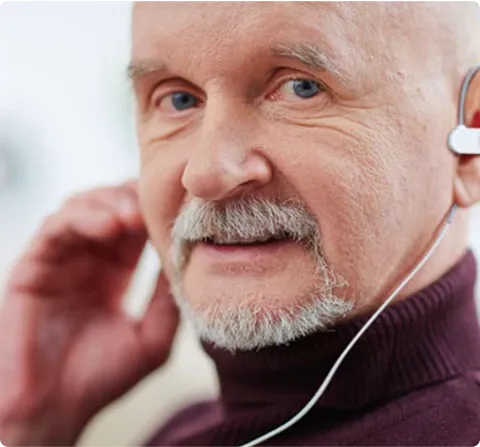
The First Scientifically Validated Device Specifically Targeting the Neurophysiological Substrate of Anxiety Issues
Nurosym is the first portable vagus nerve stimulation device with rigorous clinical validation, specifically designed to activate your parasympathetic nervous system—the biological system that regulates your body’s stress response. Clinical trials have been conducted at Harvard Medical School, UCLA, and other leading research institutions.
Unlike conventional anxiety medications that temporarily suppress symptoms by altering brain chemistry, Nurosym addresses the underlying nervous system imbalance that keeps you locked in chronic anxiety, representing the cutting edge of neuromodulation-based intervention.
- Clinical validation from over 50 completed scientific studies with thousands of participants demonstrating statistically significant reductions in validated anxiety assessment scores (BURNS Anxiety Inventory, GAD-7, STAI)
- Backed by peer-reviewed research and regulatory certifications (CE Mark medical device status), ensuring the device meets rigorous standards for both safety and therapeutic effectiveness
- Endorsed by hundreds of healthcare professionals in psychiatry, neurology, and integrative medicine for its ability to create lasting improvements in stress resilience and nervous system function
“Among similar wellness devices, it stands out for its strong research foundation and user-friendly design.”
– DEREK, US
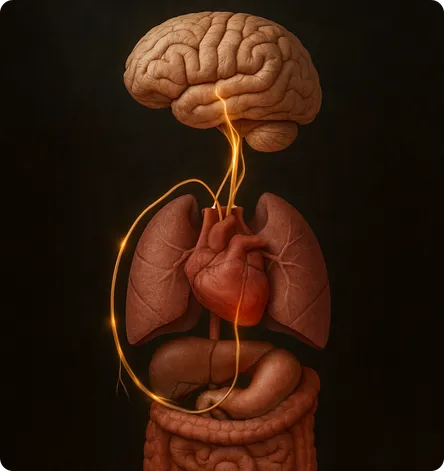
To Restore Autonomic Homeostasis and Reverse Sympathetic Dominance
The vagus nerve represents the primary pathway of your parasympathetic nervous system, connecting to nearly every vital organ and regulating heart rate, breathing patterns, digestion, and hormonal function. Anxiety disorders are fundamentally characterized by reduced vagal activity and chronic stress-system dominance.
When vagal tone—measured through heart rate variability (HRV)—is pathologically reduced, your body remains locked in a state of chronic stress overload. This creates persistent anxious thoughts, elevated heart rate, and an inability to return to a calm, recovered state.
Nurosym delivers precisely calibrated electrical stimulation to the vagus nerve through your ear, activating the nerve pathways that project to your brainstem’s primary stress-regulation center, thereby modulating anxiety-control circuits without pharmaceutical intervention or conscious effort.
- Activates your parasympathetic pathways, facilitating rapid calming signals throughout your nervous system
- Shifts your nervous system balance from chronic stress dominance toward restored calm-state function and normalized stress reactivity
- Stimulates key brainstem centers that regulate stress chemicals, mood-regulating neurotransmitters, and descending anxiety inhibition
“It helps me achieve a state of tranquility similar to meditation. The shift is subtle, but I notice feeling more at ease.”
– TOM, UK
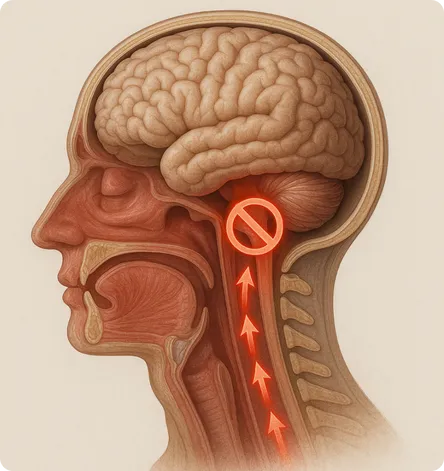
To Interrupt Maladaptive Stress Response Cascades and Reduce Amygdala Hyperreactivity
In chronic stress and anxiety disorders, repeated stress-system activation leads to cortisol dysregulation, elevated baseline stress hormones, and hypersensitization of your brain’s threat-detection centers. This manifests as persistent anxious thoughts, rumination, and loss of emotional control that impairs work performance and social functioning.
Traditional cognitive-behavioral interventions require willpower and mental control during peak anxiety—precisely when your capacity for rational thought is most compromised by stress hormones flooding your brain. Nurosym employs a fundamentally different mechanism: direct electrical stimulation of the vagus nerve that sends calming signals to anxiety-generating brain structures, interrupting the stress cascade at the brainstem level without requiring conscious mental effort.
- Reduces stress-induced activation of the amygdala (fear center) and hypothalamus (stress control center) by enhancing calming signals through vagal pathways to anxiety-regulatory brain regions
- Improves autonomic flexibility and stress resilience by restoring nervous system balance, enabling rapid physiological recovery from acute stressors without requiring willpower
- Produces measurable reductions in anxiety-center overactivation observed via brain imaging, corresponding to decreased rumination, improved emotional regulation, and enhanced mental flexibility
- 35% reduction in validated anxiety symptom scores (BURNS Anxiety Inventory) demonstrated in trial populations receiving standardized protocols[1]
“Because … of my workplace, because of really high stress … I got severe reflux. The constant push to deliver more work destroyed my organism. Each time I was putting the device I could release tension from my nervous system.”
– JAKUB, UK

For Enhanced Sleep Architecture When Anxiety Disrupts Circadian Regulation
Anxiety and insomnia create a vicious cycle: heightened arousal prevents deep sleep, while sleep deprivation worsens your brain’s fear response and reduces your ability to regulate emotions. Pre-sleep mental racing, prolonged time to fall asleep, and early morning stress hormone spikes reflect sustained stress-system activation and inadequate recovery mode engagement.
Vagus nerve stimulation enhances your parasympathetic nervous system and facilitates the transition into deep sleep stages, promoting restorative sleep architecture and improved sleep quality through nervous system rebalancing.
- Facilitates natural progression through sleep stages (light → deep → restorative) and increases deep sleep duration, enabling enhanced brain recovery and emotional processing—critical biological processes for anxiety reduction
- Supports your natural sleep-wake rhythm by reducing evening stress hormones and promoting melatonin release, helping you fall asleep faster and stay asleep longer
- Reduces pre-sleep physical and mental activation (elevated heart rate, muscle tension, racing thoughts) that prevents sleep onset, thereby breaking the anxiety-insomnia cycle
- 31% improvement in objective sleep quality metrics documented in studied populations, with particular improvements in sleep efficiency, total sleep time, and deep sleep percentage[2]
“When I wasn’t getting enough deep, restorative sleep, it impacted my mood and daily routine. Nurosym has completely transformed the way I rest.”
– DANIEL, WALES
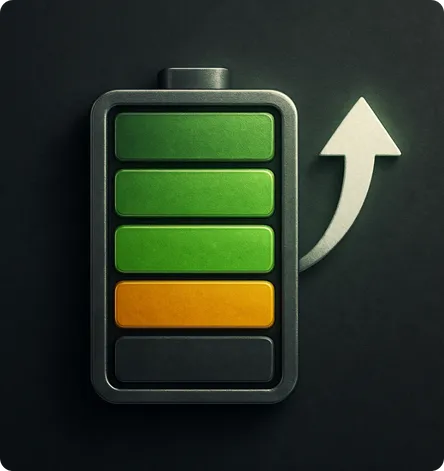
To Address Anxiety-Associated Fatigue and Allostatic Load
Generalized anxiety disorder and chronic stress induce profound fatigue through multiple mechanisms: sustained stress-system activation depletes your body’s stress-hormone responsiveness, chronic stress-mode dominance increases metabolic demand, and elevated inflammatory markers (IL-6, TNF-α, CRP) create sickness-like behavior and brain fatigue. Persistent threat monitoring and anxious rumination further deplete your mental energy reserves.
This fatigue reflects the cumulative physiological toll of chronic stress—not simply lack of rest. Nurosym restores parasympathetic function and activates your body’s natural anti-inflammatory pathway, enabling metabolic recovery and reducing the inflammatory burden that sustains exhaustion.
- Reduces stress burden by shifting nervous system balance from energy-depleting stress mode to energy-restoring recovery mode, enabling cellular energy regeneration and mitochondrial recovery
- Enhances metabolic efficiency through improved parasympathetic activity, optimizing oxygen utilization and reducing the energy cost of maintaining constant vigilance
- Reduces neuroinflammation through vagal activation of your body's anti-inflammatory pathway, suppressing inflammatory chemicals that drive brain fatigue
- Normalizes your daily stress-hormone rhythm and stress-system function, addressing the hormonal dysregulation that links chronic anxiety to persistent exhaustion
“Honestly, I’ve noticed such a positive change. I have far fewer days where I feel too drained to keep up with my daily routine.”
– FRANCESCA, UK

To Modulate Bidirectional Gut-Brain Axis Communication in Anxiety
The vagus nerve constitutes the primary communication highway of the gut-brain axis, transmitting approximately 80% of gut-to-brain signals while delivering calming nerve signals that regulate digestion, gut secretions, and local immune function. Anxiety disorders demonstrate high overlap with digestive disorders (IBS prevalence 50-90% in anxiety populations), reflecting shared dysfunction in nervous system regulation.
Anxiety-induced stress activation suppresses digestive system control, producing irregular gut motility, heightened gut sensitivity, intestinal barrier dysfunction, and gut bacteria imbalance. These gut changes amplify anxiety through vagal signaling of intestinal distress back to the brain. Restoration of vagal tone addresses both sides of this bidirectional relationship simultaneously.
- Restores parasympathetic regulation of your gut's nervous system, normalizing stomach emptying, intestinal movement, and digestive function disrupted by chronic stress
- Reduces intestinal inflammation and gut barrier permeability through vagal activation of gut immune cells and suppression of inflammatory pathways
- Reduces gut hypersensitivity by modulating pain signals traveling from gut to brain and enhancing descending pain-blocking signals from brain to gut
- Supports healthy gut bacteria balance by reducing stress-induced disruption, with emerging evidence linking improved gut microbiome to reduced anxiety symptoms through the gut-brain connection
“Since I started using it, I’ve noticed a significant improvement in how I feel overall. It’s been three months now, and I’m hopeful for even more positive changes—it’s definitely a step in the right direction.”
– TERRY, UK

To Stabilize Affective Dysregulation and Mitigate Comorbid Depressive Symptoms
Anxiety and mood disorders frequently co-occur (comorbidity rates 40-70%), reflecting overlapping dysfunction in brain chemistry systems, stress-hormone regulation, and emotional-control circuits. The nervous system imbalance characteristic of anxiety—reduced vagal tone and elevated stress activity—directly influences brain regions governing emotions: the amygdala (fear center), hippocampus (memory), prefrontal cortex (emotional regulation), and nucleus accumbens (reward processing).
Vagal nerve stimulation modulates these emotional circuits through projections to brain centers that produce norepinephrine, serotonin, and dopamine—the key neurochemicals underlying both anxiety and mood stability.
- Stabilizes mood swings by restoring nervous system balance and normalizing the brain-body stress axis that underlies emotional reactivity
- Reduces loss of pleasure and negative thinking patterns through enhanced stress-chemical and mood-chemical activity in circuits governing reward sensitivity and emotional tone
- Reduces the physical manifestations of low mood (chest tightness, slowed movement, fatigue) by normalizing nervous system arousal and reducing maladaptive stress responses
- Enhances your brain's emotional-control capacity over fear reactions by improving communication between your prefrontal cortex and amygdala, facilitating rational emotional regulation
“I was looking for a way to better navigate seasonal challenges. I had tried workouts and meditation apps but discovered Nurosym, and I noticed changes within just a couple of weeks. I feel more balanced and better equipped to manage daily pressures.”
– TIJANA, US
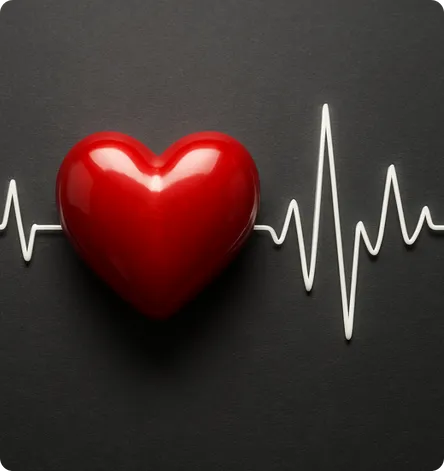
To Optimize Heart Rate Variability—A Validated Biomarker of Autonomic Function and Anxiety Risk
Heart rate variability (HRV)—the natural variation between your heartbeats—is the most reliable indicator of your nervous system’s ability to handle stress. Lower HRV is directly linked to anxiety disorders, symptom severity, and treatment challenges, while higher HRV signals a resilient, well-regulated stress response.
Low HRV reveals an overactive stress response and weakened calming mechanisms. High HRV indicates a strong parasympathetic nervous system—the biological foundation of stress resilience.
Transcutaneous vagal stimulation directly enhances vagal nerve activity to your heart’s pacemaker, increasing the natural variation between heartbeats that you can track through consumer wearables.
- Significantly increases key HRV metrics (including SDNN, RMSSD, and high-frequency HRV), demonstrating enhanced vagal control and improved nervous system flexibility
- Lowers resting heart rate and reduces stress-induced heart rate spikes by strengthening parasympathetic regulation of your heart's natural rhythm
- Improves baroreflex sensitivity—your body's rapid blood pressure control system—enhancing cardiovascular stress adaptation and overall resilience
- Delivers measurable, objective improvements trackable through consumer wearables (Oura Ring, WHOOP, Apple Watch, Polar H10) using standard HRV analysis
“I’ve noticed improved recovery indicators tracked by my fitness device and a greater ability to stay focused or train for extended periods.”
– HENRY, UK
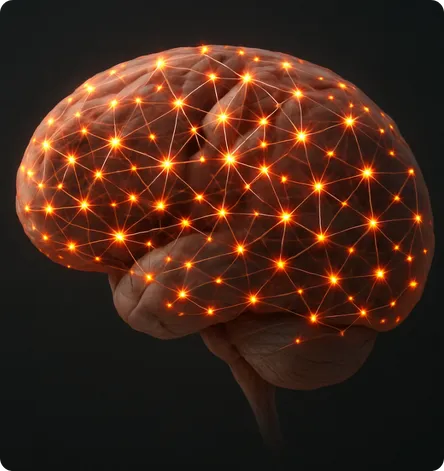
To Ameliorate Anxiety-Induced Cognitive Impairment and Executive Dysfunction
Anxiety significantly impairs cognitive performance: weakened working memory, reduced focus, slower mental processing, and diminished executive function. These deficits stem from chronic stress effects on the prefrontal cortex—your brain constantly prioritizing threat detection over goal-directed thinking.
The vagus nerve regulates mental clarity and focus through direct connections to key brain regions that control arousal, attention, and learning. Vagal stimulation increases the release of acetylcholine and norepinephrine—neurotransmitters essential for attention, memory, and cognitive control.
- Enhances neuroplasticity and memory formation in the hippocampus through increased BDNF (brain growth factor), supporting memory consolidation and mental flexibility
- Reduces mental fog and threat-focused thinking by normalizing amygdala activity and restoring balanced communication between emotional and executive brain regions
- Improves sustained attention and working memory by optimizing cortical arousal through neurotransmitter modulation in prefrontal and parietal regions
- Strengthens cognitive control and impulse regulation by enhancing dorsolateral prefrontal cortex activity, improving performance on tasks requiring executive function and mental flexibility
“Sometimes I’ll put it on while reading, and I find it helps me stay focused, even on more challenging pieces of writing.”
– YVONNE, UK

When First-Line Anxiolytic Interventions Produce Inadequate Response
Treatment-resistant anxiety—defined as insufficient improvement despite trying at least two evidence-based treatments—affects approximately 30-50% of people with generalized anxiety disorder. Standard medications (benzodiazepines, SSRIs, SNRIs, buspirone) and therapy show limited effectiveness in patients with severe nervous system dysregulation, multiple conditions, or brain chemistry that doesn’t respond to conventional neurotransmitter-based treatments.
Leading neuropsychiatrists increasingly recognize vagal nerve stimulation as a critical breakthrough for treatment-resistant cases. Vagal neuromodulation works through a fundamentally different mechanism—directly rebalancing your autonomic nervous system rather than targeting downstream neurotransmitter systems—offering a new pathway for patients who haven’t responded to conventional options.
- Non-invasive neuromodulation delivering adjunctive or standalone treatment for treatment-resistant anxiety without surgery or implantation
- Validated through over 4 million user sessions with real-world data
- 35% average reduction in standardized anxiety scores (BURNS Anxiety Inventory) demonstrated in rigorous trials[3]
- 2-4x greater vagal activation (measured via HRV and vagal tone) compared to behavioral interventions like meditation or breathing exercises when used as a standalone solution
“I often deal with tension at night that affects my face and head, but I started to notice a difference—it’s been a positive shift, even in how I feel physically.”
– HOGAN, US

As a Non-Pharmacological Alternative to Chronic Anxiolytic Medication
Standard pharmaceutical treatment for chronic anxiety typically involves long-term SSRIs, SNRIs, or benzodiazepines. SSRIs commonly cause sexual dysfunction (40-65% of users), weight gain, emotional numbness, and digestive issues. Benzodiazepines carry risks of addiction, cognitive impairment, and dangerous withdrawal.
Many patients seek evidence-based solutions without chronic medication dependency. Vagal neuromodulation delivers anxiety relief through direct nervous system regulation—activating your body’s natural calming pathways rather than altering brain chemistry—addressing the root physiological cause of anxiety without synthetic compounds.
- Avoids medication side effects—including SSRI-induced sexual dysfunction (40-65% incidence), weight gain, emotional blunting, and benzodiazepine addiction risk—by working with your body's natural regulatory systems
- Provides cost-effective long-term solution without recurring prescription costs, monitoring appointments, or dose adjustments required as your body builds tolerance to medications
- Targets the underlying nervous system imbalance (the root physiological cause) rather than temporarily suppressing symptoms through brain chemistry alterations, delivering more sustainable anxiety reduction
- Works as standalone solution or alongside existing therapy or medications, with potential for gradual medication reduction under medical supervision as your nervous system rebalances
“I was told by a professional that they weren’t sure what was causing my challenges, but a long-term approach was suggested. I started researching ways to support myself and discovered Nurosym.”
– TREVOR, UK
The Neurophysiological Mechanism: Vagal Nerve Pathway Activation
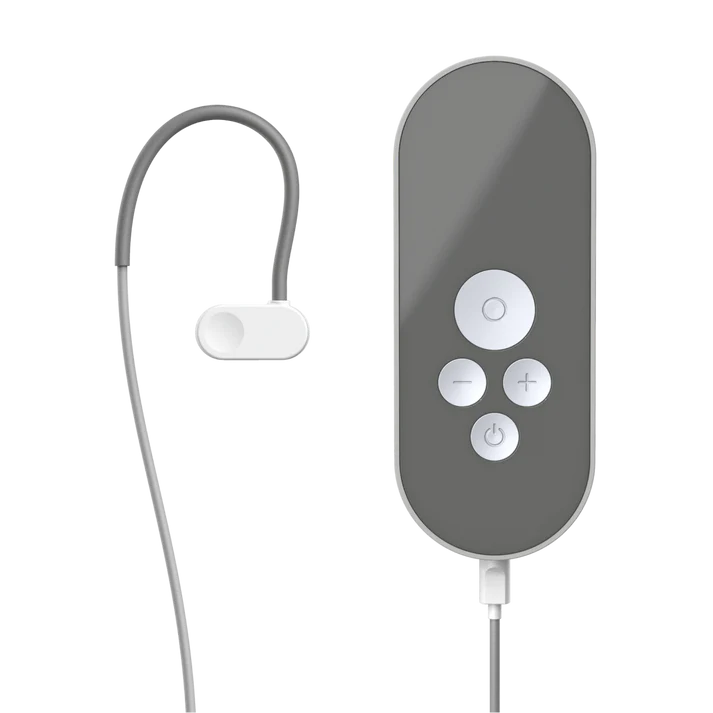
Auricular Vagal Neuromodulation Therapy (AVNT™) — Nurosym’s patented neuromodulation protocol developed through collaborative research with Harvard Medical School, UCLA, and international academic medical centers, validated through randomized controlled trials and neuroimaging studies.
Neuroanatomical Pathway and Mechanism of Action:
Nurosym delivers proprietary electrical waveforms to the auricular branch of the vagus nerve in the cymba conchae—a region with dense vagal nerve endings accessible through the skin. This activates your parasympathetic nervous system through well-established pathways:
- Peripheral activation: Electrical stimulation activates vagal nerve fibers in the ear, generating signals that travel to the brain
- Brainstem relay: These signals reach the nucleus tractus solitarius (NTS)—the primary vagal processing center and hub for autonomic nervous system regulation
- Anxiety-regulatory network activation: The NTS connects to key structures that govern anxiety:
- Locus coeruleus — regulates arousal, threat perception, and stress response
- Raphe nuclei — controls mood, anxiety levels, and sleep-wake cycles
- Periaqueductal gray — mediates anxiety suppression pathways
- Amygdala — reduces overreactivity to threatening stimuli
- Prefrontal cortex — enhances emotional regulation capacity
4. Neurotransmitter rebalancing: Multi-pathway normalization of norepinephrine, serotonin, GABA, and dopamine function
5. Autonomic rebalancing: Enhanced parasympathetic activity through brainstem connections, restoring balance between stress and calm responses
6. Anti-inflammatory effects: Activation of the cholinergic anti-inflammatory pathway, reducing inflammatory markers (TNF-α, IL-6, IL-1β) linked to anxiety
Clinical Outcome: Multi-level neurobiological intervention producing anxiety relief, stress resilience, improved autonomic function, and normalized stress hormone regulation—without pharmaceutical intervention or conscious effort.
Clinical Efficacy: Randomized Controlled Trial Outcomes
Primary Results from Parasym Clinical Research Program:
- 35% average reduction in BURNS Anxiety Inventory scores (p<0.001) in intention-to-treat analysis
- Significant reduction in stress biomarkers: Normalized stress hormone patterns, improved cortisol rhythm, and decreased inflammatory markers (IL-6, TNF-α, CRP)
- Enhanced cardiac vagal tone: Significant increases in key HRV parameters (RMSSD, SDNN, HF-HRV power), indicating restored parasympathetic function
Transcutaneous auricular vagus nerve stimulation produces measurable increases in cardiac vagal tone and reduction of inflammatory signaling—both established mechanisms underlying anxiety resilience.
Clinical significance: The 35% reduction matches the effectiveness of first-line medications (SSRIs: 30-40% reduction), without the side effect burden.
A Next Step Toward a More Regulated Nervous System
If you recognize yourself in the patterns described here — the persistent tension, the difficulty returning to calm after stress, the sense that your body is running ahead of your mind — it is not a personal failing. It is the nervous system doing what it has learned to do under prolonged demand.
The research is clear: when the vagus nerve’s regulatory capacity is strengthened, the system begins to shift. Thought patterns soften. Sleep deepens. Physical tension quiets. The body remembers how to settle.
Nurosym is designed for individuals who are thoughtful, discerning, and intentional about how they support their mental and physiological functioning. It is not about chasing quick relief. It is about restoring the underlying regulatory architecture that calm, clarity, and resilience depend on.
If you are looking for:
- A non-pharmacological approach supported by controlled trials
- A solution that works with the body’s own calming pathways
- A way to gradually rebuild stress tolerance and emotional steadiness
Then beginning a structured neuromodulation protocol may be a meaningful next step.
Individual results vary based on baseline anxiety severity, degree of autonomic imbalance, co-occurring conditions, treatment consistency, and individual physiological differences.
Resources:
- Auricular Vagal Neuromodulation Therapy (AVNT) — Anxiety Symptoms Reduction in Long COVID Patients After Auricular Vagal Neuromodulation Therapy, Nurosym Ltd. The 10-day home-based protocol (two 30-minute sessions per day) in Long COVID patients showed a significant and sustained reduction in anxiety scores (p < 0.001). Available at: https://nurosym.org/fr/pages/anxiety-symptoms-reduction-in-long-covid-patients-after-auricular-vagal-neuromodulation-therapy
- Auricular Vagal Neuromodulation Therapy (AVNT) — “Improves Sleep Score in Long COVID: A Pilot Study”, Nurosym Ltd.. The 4-week home-based protocol (one 30-minute session daily) reported a ~31 % reduction in sleep-disturbance scores (PSQI) among participants with Long COVID (p = 0.036). Available at: https://nurosym.org/fr/pages/auricular-vagal-neuromodulation-therapy-improves-sleep-score-in-long-covid-a-pilot-study
- Nurosym Ltd.. Anxiety Symptoms Reduction in Long COVID Patients After Auricular Vagal Neuromodulation Therapy. The 10-day home-based protocol (two daily 30 min sessions) in Long COVID patients showed a statistically significant reduction in anxiety scores from baseline to post-intervention and at 1-month follow-up (F(2, 46) = 14.46, p < 0.001). Available at: https://nurosym.org/fr/pages/anxiety-symptoms-reduction-in-long-covid-patients-after-auricular-vagal-neuromodulation-therapy
Share via:


